Last Updated on December 13, 2023 by
While there are many things to do in Rotterdam, the highlight of the city lies in its modern architecture.
As a tourist, it is only fair to visit all of these landmarks that make Rotterdam architecture stand out.
Table of Contents
WHAT MAKES ROTTERDAM ARCHITECTURE SPECIAL?
While most cities around the world take pride in its historical heritage, Rotterdam is all about modern architecture. So much so that, tourists consider visiting Rotterdam as of the best options for day trips from Amsterdam.
Rotterdam was destroyed in World War II and was rebuilt entirely. This is the reason why the new buildings in Rotterdam are modern and sustainable.
Rotterdam Centraal Station
One of the best architecture in Rotterdam starts with the entry into the city.
Rotterdam Centraal Station underwent a 7-year redevelopment and opened in 2014 and has all the modern and sustainable features. It has also retained some of its original artefacts like the clock.
The new station uses contemporary materials such as solar panels and is made of steel and wood.
The exterior of the station is the highlight of Rotterdam. The building has a triangular shape that points towards the sky at a protruding angle. Because pointing towards the city centre, the roof’s V-shaped corner shows you exactly which way to go.
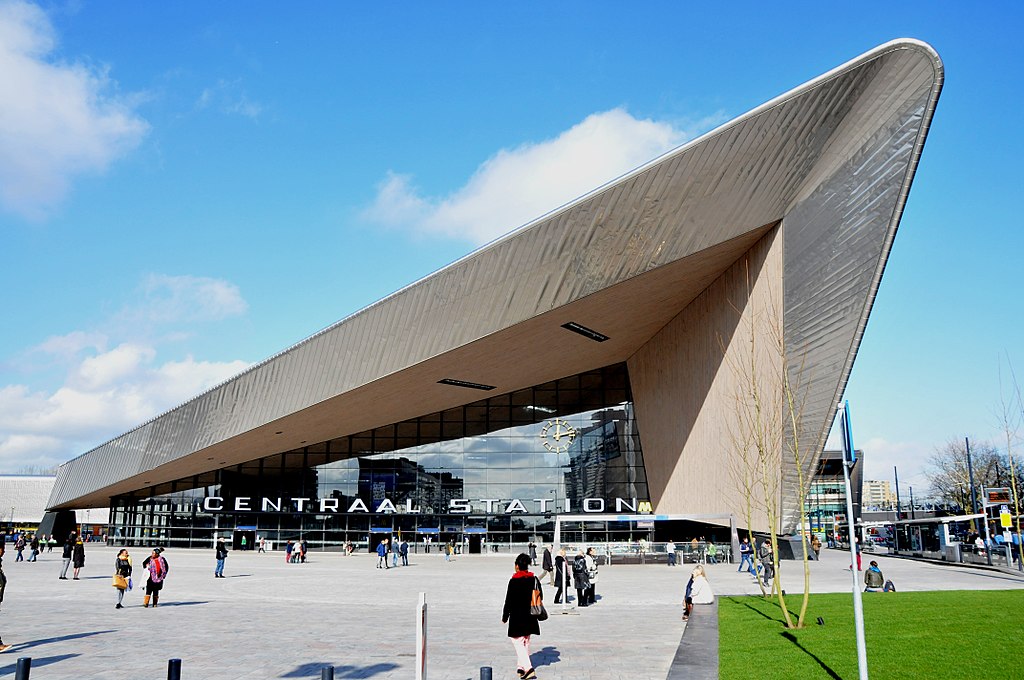
Rotterdam Centraal Station – The best Architecture in Rotterdam
The Markthal (Market Hall)
The Market Hall in Rotterdam is a sustainable combination of a market selling food, restaurants, apartments, parking, and public transportation, all integrated to enhance the synergistic possibilities of the different functions all under one roof.
It also has the world’s largest artwork on the ceiling. Its bright colours cover an area of 11,000 square meters, resulting in this creation now being known as Rotterdam’s very own Sistine Chapel.
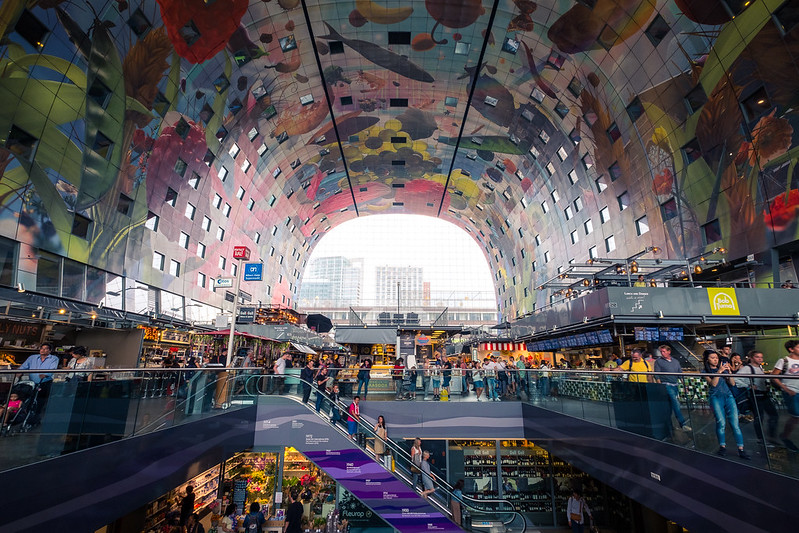
Markthal Rotterdam – Best Rotterdam attractions for architecture
The Dak Park
Dak Park literally means Roof Park.
Dak Park is a public garden on the roof of a shopping centre which supports businesses, restaurants and parking spaces. Measuring 1,200 metres in length and 85 metres in width, it is the largest public roof park in Europe.
With ample biodiversity on the top like indigenous trees, the park is accessed by a wide stairway, with a waterfall in the middle. If you look closely you will be able to spot rabbits here.
The local community has taken up the ownership of this project and attends to a compost plant in the vicinity of the park.
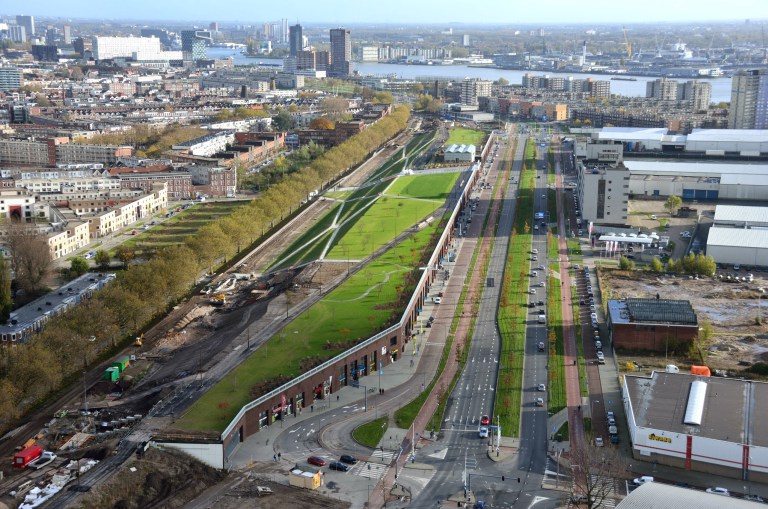
Dakpark Rotterdan | PC: www.dakpark.nl
Erasmusbrug
The Erasmus Bridge (Erasmusbrug) is a combined cable-stayed and bascule bridge in the centre of Rotterdam, connecting the northern and southern parts of the city. The bridge is also known as ‘The Swan or Zwan’. This is one of the Architecture in Rotterdam that visitors should not miss.
It is an architectural marvel and can be visited by going on a run over it, taking a tram, a car or a water bus under it. If this does not give you a feeling to appreciate its beauty, have a meal or two in the restaurants nearby overlooking the bridge.
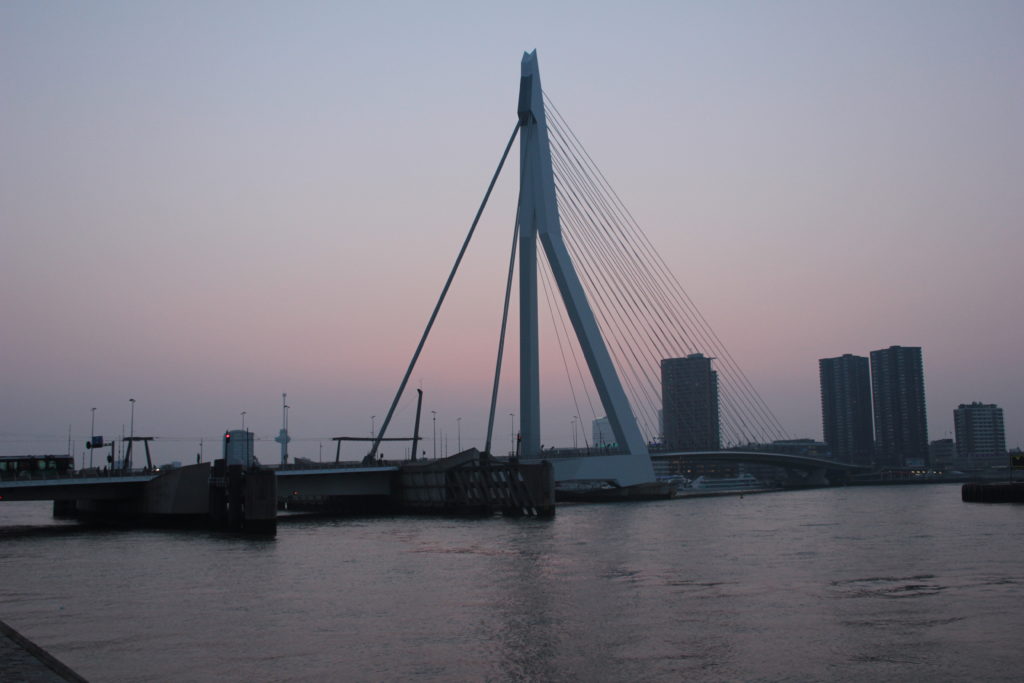
Rotterdam Architecture – Erasmus bridge
Floating pavilions
Architects have developed floating houses to help maximize living space in Rotterdam, which has vast areas of water.
They believe floating farms may be a way for the cities of the future to feed their growing populations and reduce pressure on land. This floating Pavilion in the Rijnhaven area is used to host events.
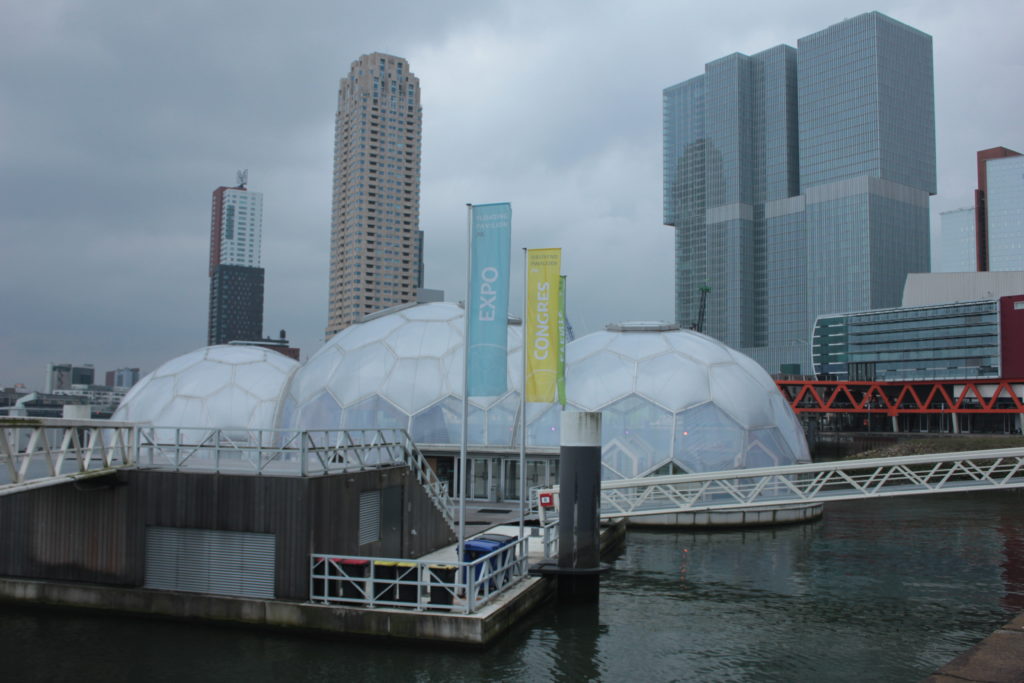
Floating pavilions of Rotterdam
Cube houses of Rotterdam
Cube houses are a set of innovative houses based on the concept of “living as an urban roof”.
It is high-density housing with sufficient space on the ground level since its main purpose is to optimize the space inside. Each house is tilted 45 degrees and rested upon a hexagon-shaped column that contains the entrance and stairway. The architect wanted to represent a village within a city, where each house represents a tree, and all the houses together, a forest.
Living in the cube house requires quite a bit of imagination and adaptability of residents as they must be creative enough to place furniture in this house. You can experience staying in these houses by spending a few euros. Book here.
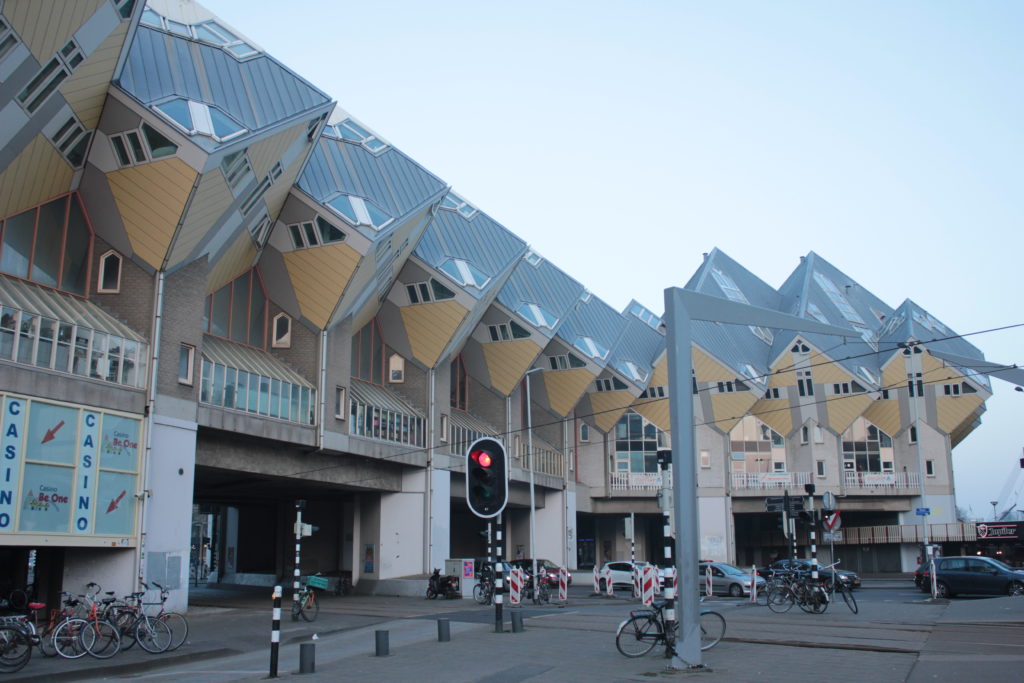
Cube Houses of Rotterdam
Hotel New York
Hotel New York is a significant historical landmark in Rotterdam. This 4-star property has a gorgeous rooftop terrace with a bar overlooking the Rhine river.
Hotel New York is based in the former head office of the Holland America Line. This exemplary 1901 Art Nouveau building was once the departure point of Dutch immigrants who set sail to America.
Book your historical Rotterdam accommodation here.
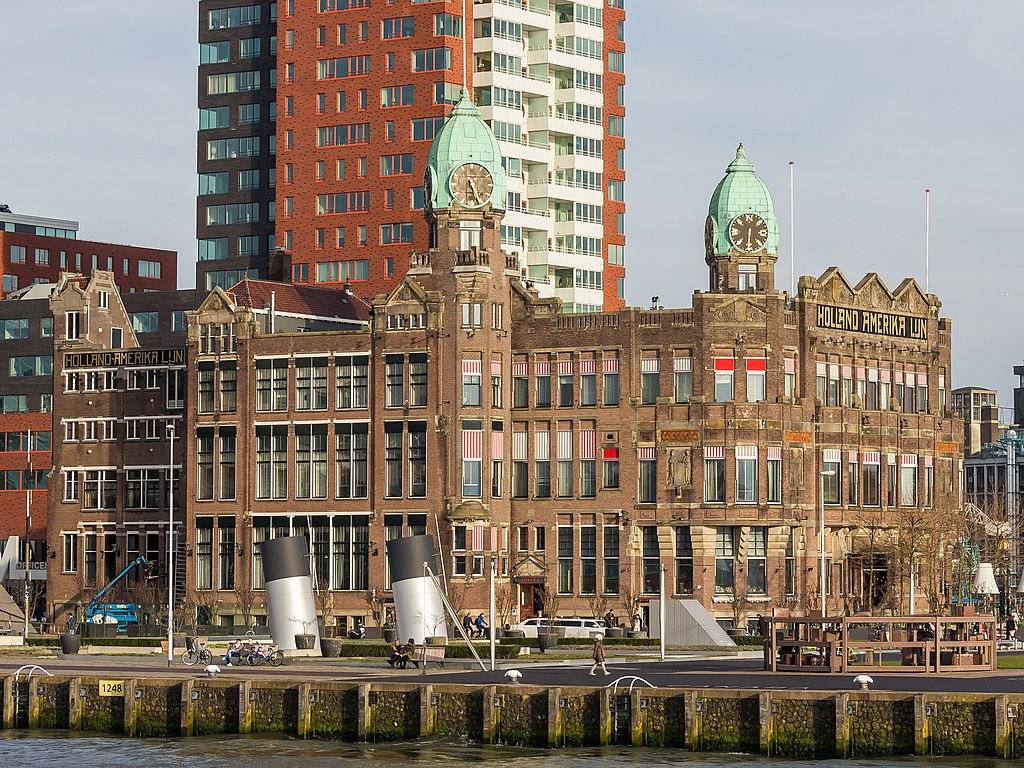
De Rotterdam
De Rotterdam (The Rotterdam) is an interesting-looking landmark overlooking the Erasmusburg and Rhine river. The building is named after one of the original ships on the Holland America Line.
Designed as a ‘vertical city’, De Rotterdam consists of three linked towers. The towers are each 150 metres tall with 44 floors and are spread over an area of 162000 m².
All 3 buildings consist of apartments, offices, shops and restaurants, making this building a mini city in Rotterdam.
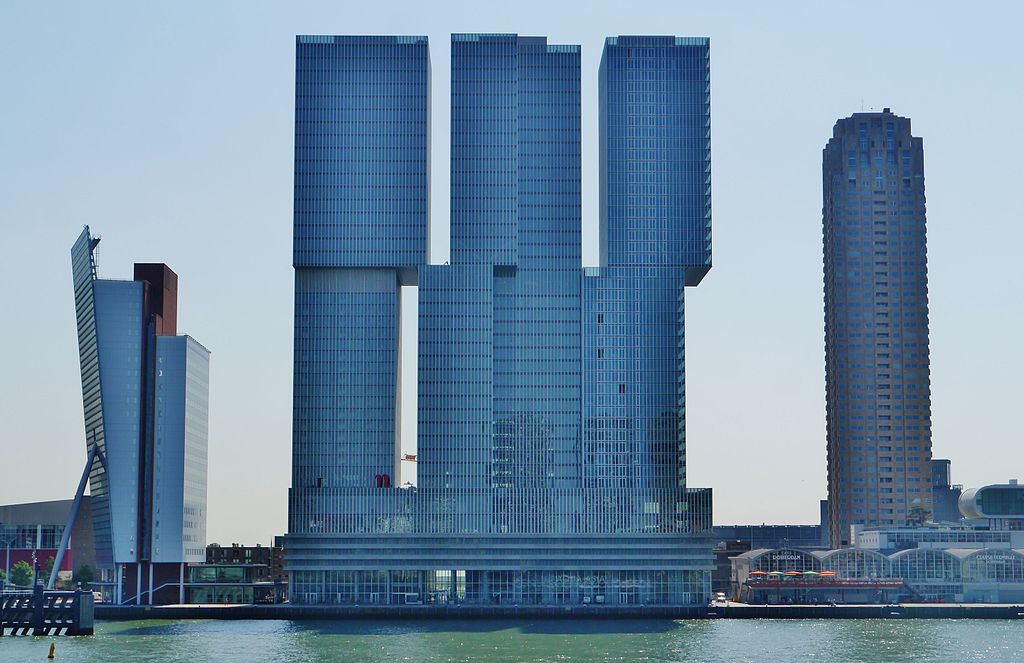
Witte Huis
Built in the late 18th century, the 43m tall Witte Huis (White House) was Europe’s first-ever skyscraper. And it is not surprising that it still stands against modern skyscrapers.
Due to its white exterior made of white glazed brick, it is called the White House. Constructed in the Art Nouveau style, it consists of features such as fairy-tale turrets, mosaics and stone sculptures. Due to its traditional architecture, Witte Huis is recognised as a National Heritage Site.
In summers, the rooftop viewing platform is open to the public, which provides beautiful panoramic views of other Rotterdam architecture.
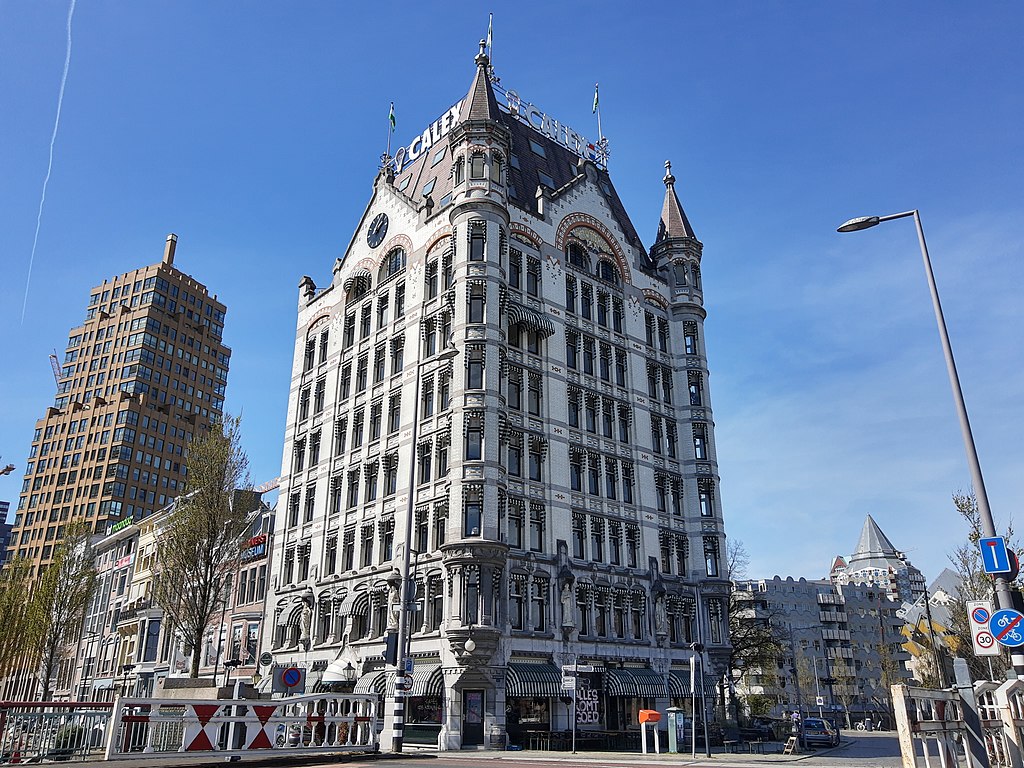
Kunsthal
Kunsthal is said to be the Netherlands’ first ‘Art Hall’. It is a display space that hosts art and craft exhibitions.
The building is made of steel, marble and corrugated plastic. The main architectural feature of Kunsthal is the gently sloped ramp that leads visitors from the ground floor to the top, visiting the seven gallery spaces along the way. Every gallery space is unique which is why is one of the unique architecture in Rotterdam.
One of the most important features of the building is that it looks different from each angle.
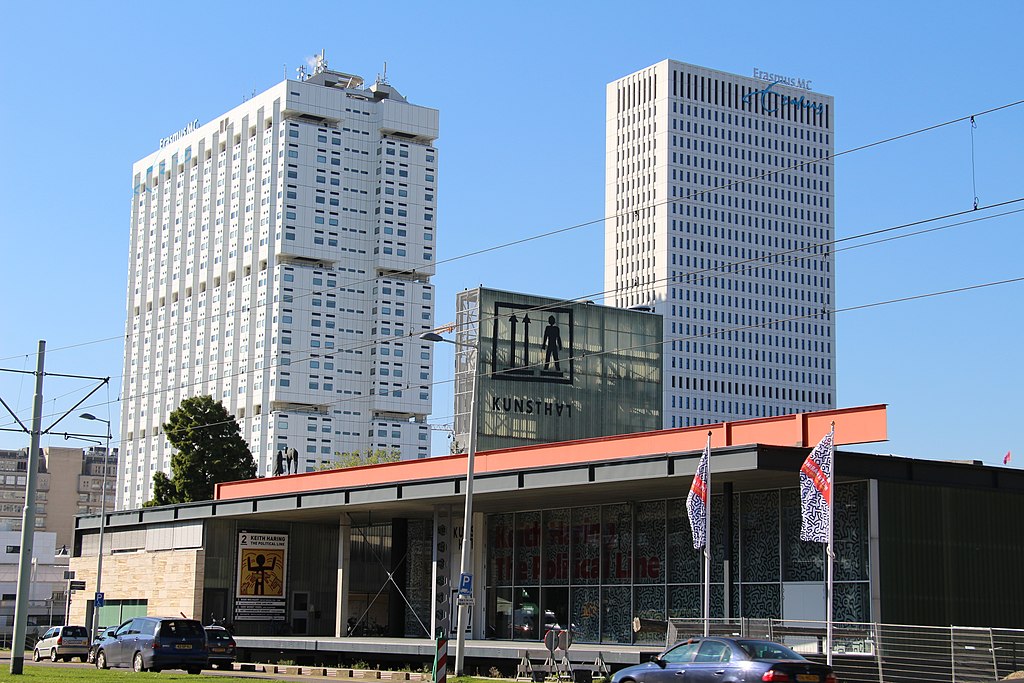
Depot Boijmans
Depot Boijmans Van Beuningen is the first depot in the world that offers access to a complete museum collection.
This is a depot and not a museum which means there are no exhibitions, but visitors can catch a glimpse of behind the scenes of the museum world. Visitors can wander – independently or with a guide – through the building. There are 151,000 art objects to explore in the depot.
It wants to break the barrier of international museums which can only showcase six to seven per cent of their collections in exhibitions. The remaining 94 per cent is hidden in storage. The Depot Boijmans Van Beuningen breaks with this tradition of concealment as the design makes visible all these previously invisible artefacts in a unique and iconic reflective building,
The Depot features exhibition halls, a rooftop garden, and a restaurant, in addition to an enormous amount of storage space for art and design.
Depot Boijmans is also sustainable as the construction has utilized sustainable materials and technologies.
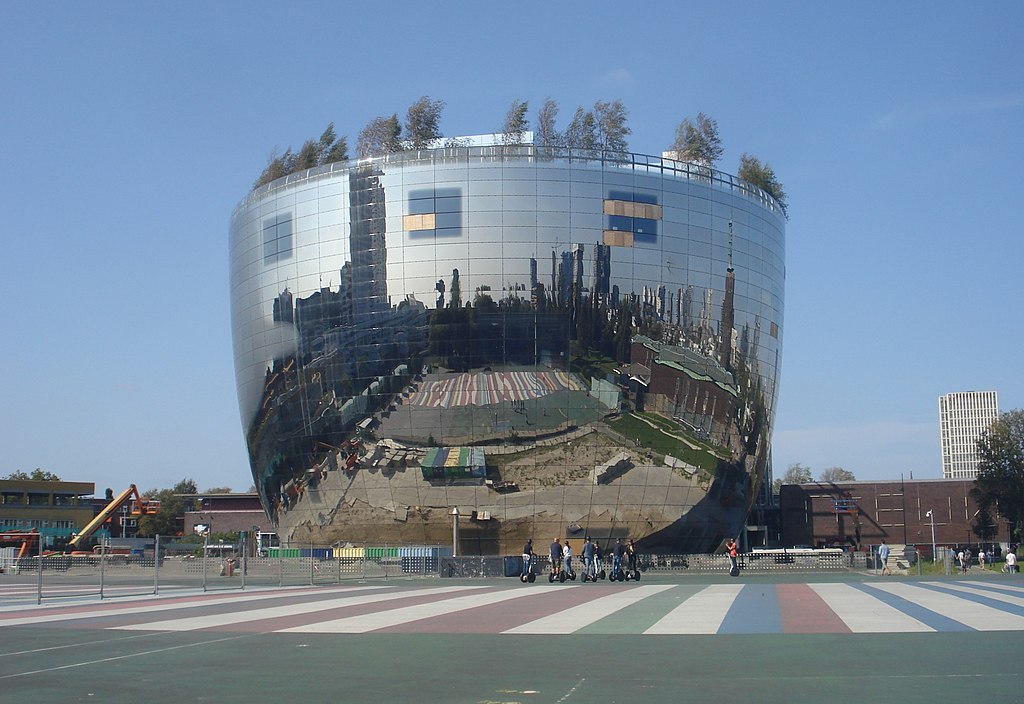
Timmerhuis
Have you ever played the Tetris game? Timmerhuis (Carpenter’s House) looks like that in real.
The building consists of stepped modular blocks kept upon each other.
Unlike its more traditional brick-built neighbours, the 15-storey structure is designed to express its contemporary steel structure. Timmerhuis accommodates municipal services, offices, restaurants and residential units.
And with its materials being entirely recyclable, it’s also one of the most sustainable mixed-use buildings in the Netherlands.
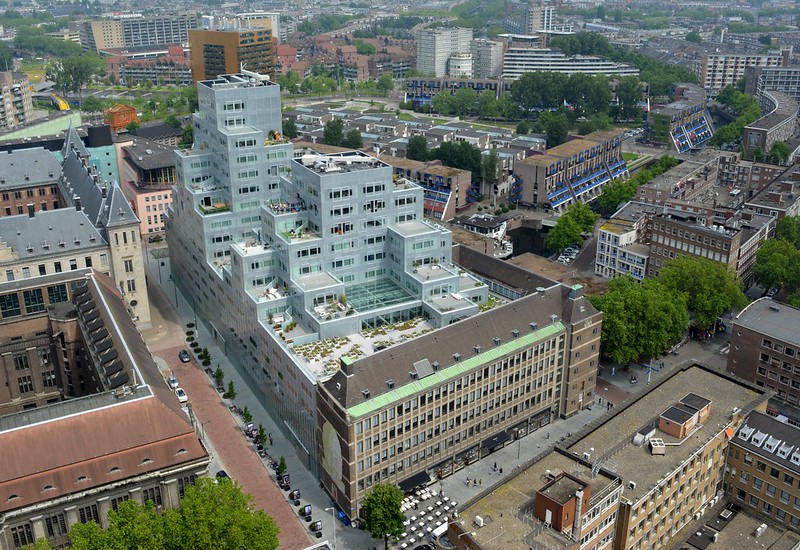
Van Nelle Fabriek
Van Nelle Fabriek (Van Nelle Factory) is an industrial architecture turned into commercial use. It is a UNESCO Heritage site.
It’s a large building complex that consists of several factories where they used to produce imported goods like tobacco, tea and coffee.
Van Nellefabriek was designed and built in the 1920s and was one of the icons of 20th-century industrial architecture, comprising a complex of factories, with façades consisting essentially of steel and glass, making large-scale use of the curtain wall principle.
It is now a perfect location for events, conferences and trade fairs. It also doubles up as an office complex and museum.
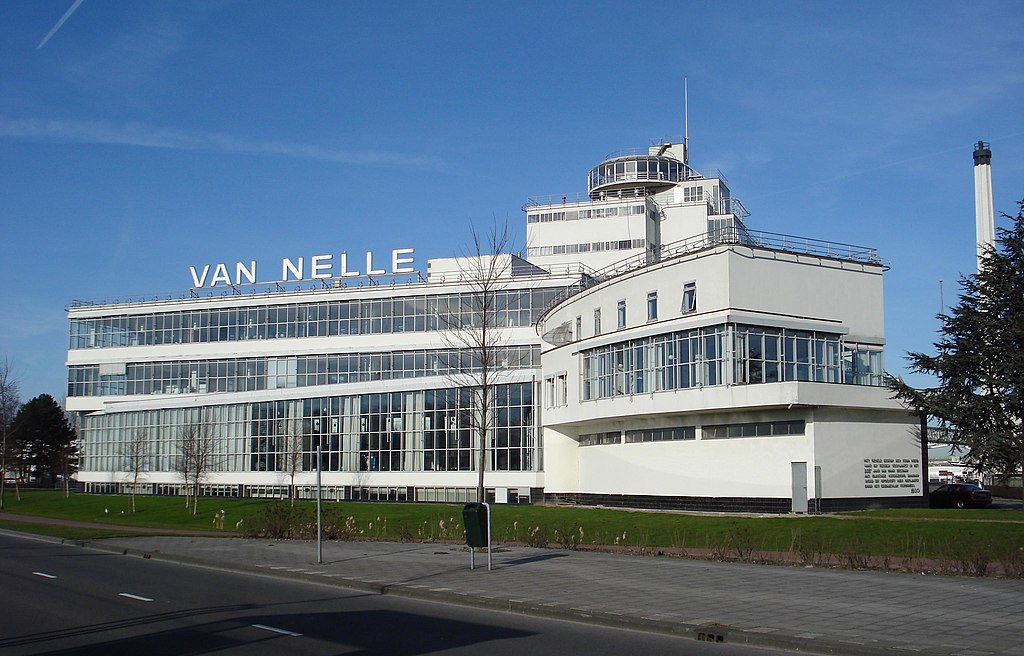
Pauluskerk
This futuristic-looking building is of St. Paul’s Church.
Unlike a typical church, the building functions as multifunctional accommodation. St. Paul’s Church remains a centre for the parish where anyone can enter.
There are spaces for social and diaconal work, medical care, assistance for refugees, assistance with the return of refugees to their country of origin, art and music by visitors and temporary housing.
Local residents and other third parties may use spaces.
The church houses a large, multipurpose hall that can be utilised for wedding and funeral services.
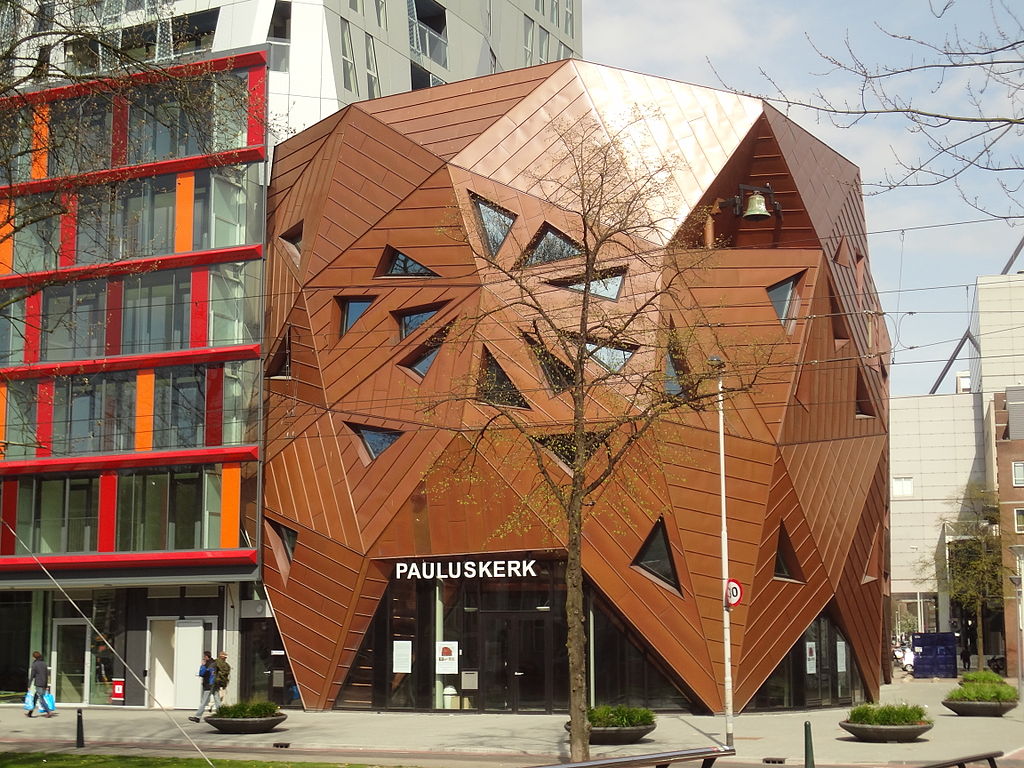
Euromast
The Euromast Tower is an observation station in Rotterdam. The tower stands at 606 feet, making it the tallest building in Rotterdam.
Euromast is a National Monument and it’s part of the World Federations of Great Towers. Other iconic towers on the list include the Eiffel Tower (Paris), Burj Khalifa (Dubai), Berliner Fernsehturm (Berlin), Tokyo Tower (Tokyo) and many others.
The Euromast has a restaurant, a conference room for business meetings, a hotel suite and an observation deck. The observation deck provides panoramic views of Rotterdam city.
Euromast also paints a pretty picture across Rotterdam city as it can be seen from everywhere.
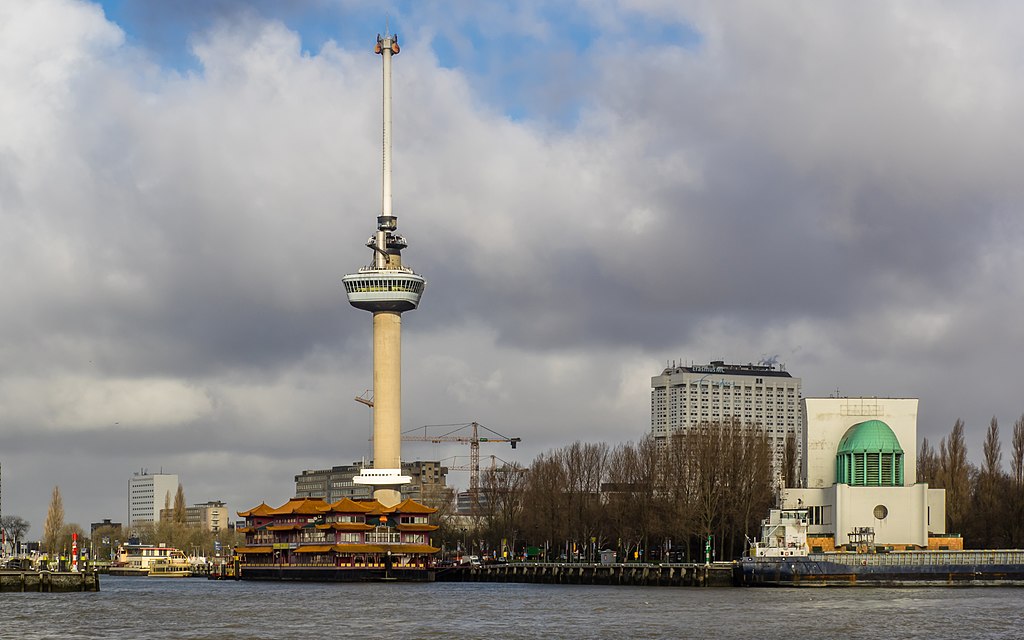
Rotterdam architecture tour
If you loved this post and want to go on a Rotterdam architecture tour then there are many that are offered. Check this tour.
Sustainable tips for Exploring Rotterdam Architecture
- Rotterdam is an extremely bike-friendly city so use the bike or the city’s efficient public transportation to explore the architecture in Rotterdam.
- Try the restaurants in Markthal, Dak Park, De Rotterdam and other aesthetic buildings of Rotterdam. Most of them serve local food and offer amazing views of the city.
- Do not litter in these buildings and around them. Dispose of plastics in the designated waste bins.
- Respect the churches, museums, walls and old architectural buildings by not sitting on them.
Disclaimer – This post contains affiliate links. It means it adds no extra cost to you if you book through the link but I get a referral bonus which helps me earn a little to keep this website up and running.
Pin this post!
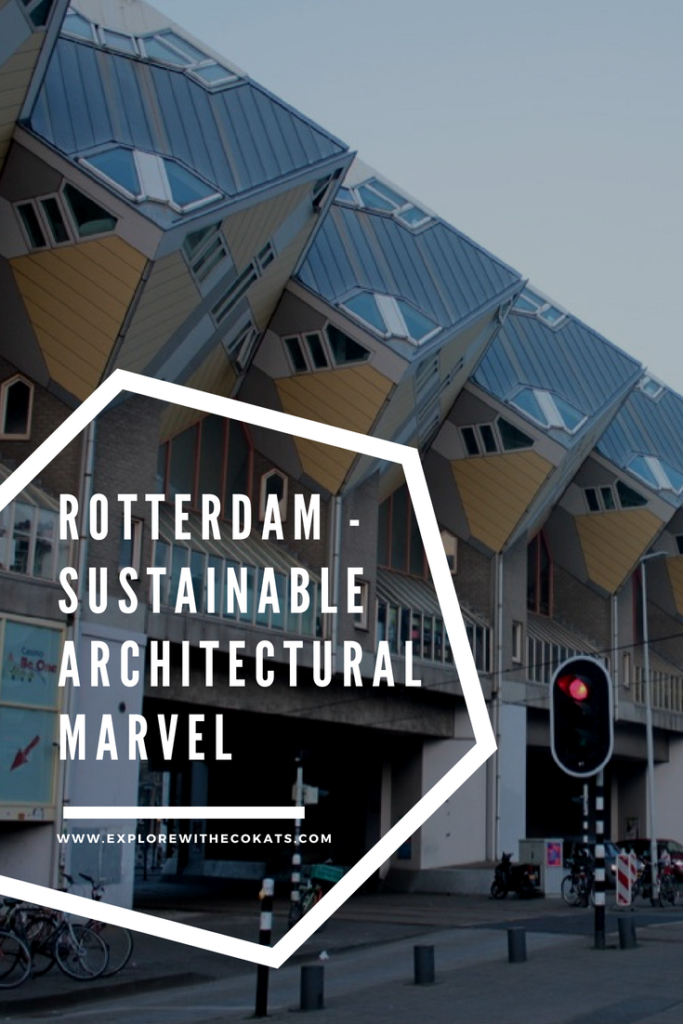


1 comment
The Dakpark is such a brilliant use of space to provide some more greenery for a city! I’m yet to visit Rotterdam but as I cruise frequently hope to see the city one day!
Francesca x // glutenfreehorizons.com